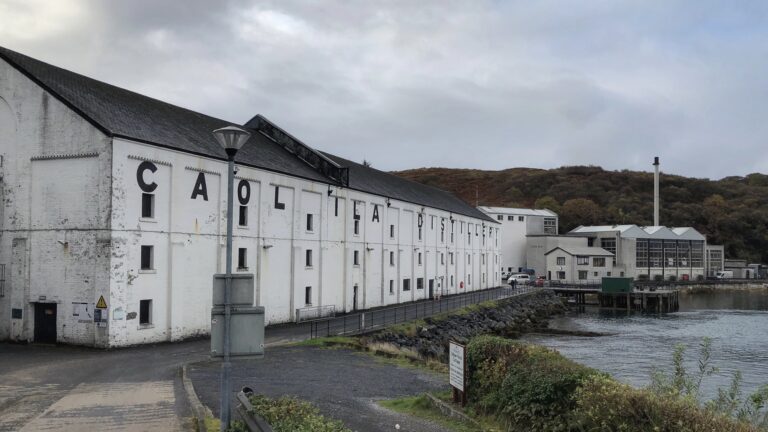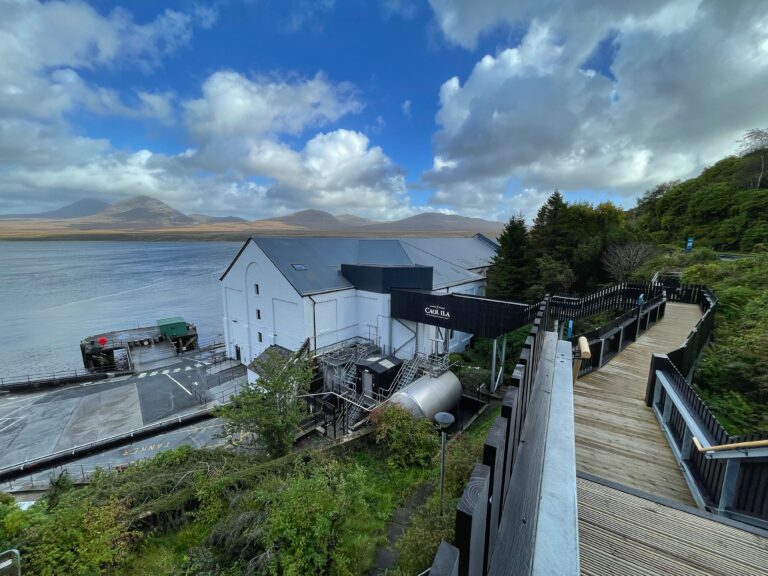Distillery Profiles:
Caol Ila

Introduction
Caol Ila overlooks the sound of Islay, the fast-flowing strait that separates the island from neighbouring Jura. The name comes from the Gaelic, Caol Ìle, meaning Sound of Islay.
The distillery is owned by Diageo and is the largest in Islay, capable of producing some 6,000,000 litres per annum. Most of the whisky produced onsite is ringfenced for the owner’s blended Scotch portfolio, though it is a fine single malt in its own right.
Character
Caol Ila’s spirit is distinctively coastal and smoky but also has a lightness and a freshness that sets it apart from Islay’s other distilleries.
The majority of the whisky produced is matured in bourbon casks though other casks are used depending on the desired flavour profile. There is a distillery-exclusive bottling that includes spirit finished in Californian red wine casks.
Place and Production
The distillery stands just to the north of Port Askaig and visitors can enjoy stunning views across the sound to Jura and its magnificent paps.
The water used in whisky production comes from Loch Nam Ban, The reservoir drains through a stream that enters the Sound of Islay beside the distillery. The clear spring water rises through limestone, giving it a high mineral content.
Caol Ila’s barley requirements are met by the Diageo-owned Port Ellen Maltings in the south of the island. The malt is peated to around 40ppm. The specifications are identical to the malt used at Lagavulin but thanks to differences in production techniques, the spirits are radically different.
Caol Ila ferments in wooden washbacks for an average of 55 hours and the resultant wash is distilled in tall, onion-based stills. The height of the stills, coupled with a relatively high cut point reduces the peatiness of the spirit.
Very little of Caol Ila’s whisky is matured on Islay. Most is shipped off in tankers to be filled into casks and matured in one of Diageo’s vast warehousing complexes on the mainland.
Caol Ila is an excellent malt but much of its spirit goes into blends and the distillery is often associated with the Johnnie Walker brand, and in particular, Black Label.
History & Notable People
Hector Henderson
The distillery was founded in 1846 by Hector Henderson, owner of Littlemill Distillery in West Dunbartonshire. There was no road to the site so Henderson brought raw ingredients in by boat and shipped his whisky off to the mainland the same way.
In 1857, improvements were made to the site, including the construction of a pier which allowed smaller ships to load and unload at the distillery. In those days, Islay was regularly served by a plethora of small steamships, known as Puffers. These coal-fired cargo ships provided a crucial lifeline to Islay and other Hebridean islands for many years.
Bulloch Lade & Co
Bulloch Lade was founded in Dunbartonshire in 1817 by corn dealer, John Bulloch. Bulloch built Duntocher Distillery, later to be renamed Auchentoshan and would go on to own four distilleries in total.
In 1863, his company bought Caol Ila and four years later, another Islay distillery followed in the shape of Lossit. The latter was on its last legs by then and though Bulloch Lade used its spirit in blends, the distillery never produced again. Lossit closed in 1870 but Caol Ila would continue to thrive and when Bulloch Lade was declared bankrupt in 1920, its assets were snapped up by the Distillers Company Ltd (DCL), including Caol Ila.
George Leslie Darge
George Leslie Darge was an architect employed by DCL to redesign and rebuild several of their distilleries in the 1960s and ‘70s. Born in Edinburgh in 1919, he followed his father into the family business, Darge & Thomas, quantity surveyors and architects.
In 1953, George moved to Speyside to join a new, in-house team of architects, surveyors and engineers at Scottish Malt Distillers (an off-shoot of DCL). Soon he was promoted to the position of Chief Architect, a role he would hold for 28 years.
Darge worked on a total of 46 distilleries in a long and industrious career, including the demolition and reconstruction of Caol Ila in 1972. The still-house, for which the distillery has become famous, with its floor-to-ceiling windows that overlook the Sound of Islay, was his design and was said to be inspired by the tall windows of the DCL office building on Glasgow’s Waterloo Street.
Darge’s Waterloo Design, as it became known, was installed at several distilleries – Glen Ord, Clynelish and Craigellachie among them – but nowhere is it better showcased than at Caol Ila with its spectacular panoramic views.
Diageo and Johnnie Walker
Caol Ila was never directly under the ownership of John Walker & Sons but the blender joined DCL in 1925, making it a stablemate of the Islay distillery. Through a long and complicated series of takeovers, mergers and name changes, DCL would eventually become Diageo, which retains ownership of both Johnnie Walker and Caol Ila today.
In 2019, Diageo was granted planning permission for a new visitor centre at Caol Ila that would improve accessibility to the site and bring it under the new Johnnie Walker Four Corners umbrella. The work was completed in 2022.

Curious Tales
When Hector Henderson established Caol Ila, there were no roads linking the distillery with Port Askaig. Supplies were delivered by sea and Henderson used a small fleet of ships to carry barley to the island before sailing off with their holds full of new whisky.
It was a risky business, however. A fact exemplified by an article in the Elgin Courant of Friday 27th April 1847. The Salima, a brig belonging to Henderson, was sailing from Inverness to Islay with a cargo of barley. On the 8th of April, there was a terrible storm as the vessel rounded the northern tip of Scotland and it got into difficulty near Dunnett Head. “It was observed that she was dragging her anchors, and the master proceeded to cut away one of the masts, but she immediately struck on the face of a rock and split fore and aft.” The mast fell onto a rock and a mate was able to climb along it to safety, finding a hole in the rock in which he could shelter. The cook managed to swim to the same rock but whilst the mate could hear him, he couldn’t see him and by morning, there was no sign, leaving the mate as the lone survivor of the six-man crew.”
Now there’s a tale that puts the current failures of the Cal Mac service into perspective.



